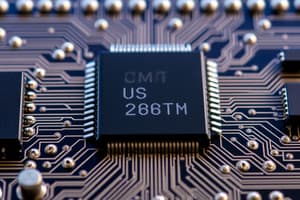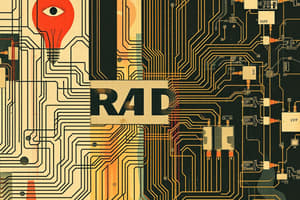Podcast
Questions and Answers
What is the primary characteristic of a sequential circuit in digital systems?
What is the primary characteristic of a sequential circuit in digital systems?
- It requires continuous power supply to function.
- It stores previous states and is dependent on past inputs. (correct)
- It operates solely based on current inputs.
- It can only produce outputs based on external triggering.
Which of the following is NOT a common element found in a sequential circuit?
Which of the following is NOT a common element found in a sequential circuit?
- Counters
- Registers
- Flip-flops
- Multiplexers (correct)
Which statement correctly describes a clock signal in a sequential circuit?
Which statement correctly describes a clock signal in a sequential circuit?
- It only influences the inputs, not the outputs.
- It is irrelevant to the operation of sequential circuits.
- It determines the voltage levels of the outputs.
- It synchronizes the state changes within the circuit. (correct)
In a state transition diagram, what do the arrows represent?
In a state transition diagram, what do the arrows represent?
Which type of flip-flop is known for its ability to store one bit of data and has two stable states?
Which type of flip-flop is known for its ability to store one bit of data and has two stable states?
Flashcards are hidden until you start studying
Study Notes
Sequential Circuits in Digital Systems
- Characterized by outputs that depend on current inputs and past states, allowing for memory storage and state retention.
- Use internal feedback to maintain a history of input states.
Common Elements in Sequential Circuits
- Typical elements include flip-flops, latches, and clock signals.
- An element not commonly found in sequential circuits is combinational logic, which does not store state information.
Clock Signals in Sequential Circuits
- Clock signals synchronize changes in state, enabling predictable timing for state transitions.
- They dictate when data is read or updated within the circuit.
State Transition Diagrams
- Arrows represent transitions between different states in the system, indicating how the circuit changes from one state to another based on inputs.
- Diagrams visualize the behavior of sequential circuits and the relationships between states.
Flip-Flops
- The D flip-flop is known for its ability to store one bit of data, operating with two stable states (0 or 1).
- Flip-flops are essential for data storage and are the building blocks for more complex memory elements in digital systems.
Studying That Suits You
Use AI to generate personalized quizzes and flashcards to suit your learning preferences.




